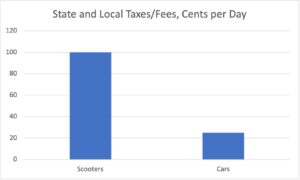In Miami, e-scooters pay four to 50 times as much to use the public roads as cars
If we want to encourage greener, safer travel, we should align the prices we charge with our values
Florida is home to some of the most unsafe cities to be a pedestrian or a cyclist. Miami is currently attempting to change their image as an auto-dominated city and create a more inclusive transportation network along their downtown streets. They hope to increase the safety of bikers, pedestrians, and e-scooter riders. The Miami-Dade County of Transportation and Public Works Department plans to add bollards and concrete barriers along three miles of city streets to create protected lanes for bikes and scooters. Part of their plan to pay for this new infrastructure? A daily fee on e-scooters. The tax code reads that:
“operators shall remit to the city a motorized scooter fee in an amount of $1.00 per motorized scooter per day. The motorized scooter fee shall be calculated monthly based on the number of scooters authorized by the city of the current period…. During the duration of the pilot program, this motorized scooter fee shall be designated for sidewalk/sidewalk area, and/or street improvements within pilot program area.”
At City Observatory, we examined Portland’s scooter pilot program in 2019. The implementation of e-scooters into the city had positive results. Scooters were most used during peak travel hours, consequently reducing congestion. They provided a greener solution for people to make short trips throughout the city’s downtown. The program was successful and popular, but it left us wondering about how differently the Portland Bureau of Transportation treats these micro-mobility solutions as opposed to large, gas-guzzling automobiles. In Portland, we estimated that scooter riders were paying ten times as much in fees per mile traveled than car users pay in gas taxes. For example, if payments were based on the amount of space taken up on the streets or the pollution generated, drivers should have been paying significantly more than scooter users.
Miami’s new pilot program is another example of this stark double standard. Once again, we focus on how much the city charges different vehicles to use its roads. Miami’s tax code charges each scooter $1 per day. How does that compare to what it charges for a car?
Gas taxes are a key source of local and state revenue for road infrastructure. The total tax imposed in Miami-Dade County on gasoline sums to 36.6 cents per gallon. If we assume the average car gets about 25 miles per gallon, the average vehicle in Miami pays a little more than 1 cent per mile traveled. Miami residents drive 19.2 miles daily according to the Federal Highway Administration. After some quick math, our estimate for the daily price car users pay in Miami comes to roughly 25 cents. This means, on a daily basis, e-scooters pay four times more per day than cars do.
Another way to look at this is to consider the amount the city charges per mile. A case study analyzing the e-scooter program in Indianapolis provides us with a template of what micro-mobility travel could look like in a major city like Miami. The Indianapolis e-scooter program averaged 4,830 trips per day and a median number of scooters in service per day of 1,654. This gives us an estimate of 2.92 daily trips for a unique scooter. The median trip length in this program was .7 miles. If we assume that Miami would see similar daily usage, scooters paying the city’s daily dollar fee pay roughly 34.2 cents per trip and 48.9 cents per mile. As we estimated above, the average vehicle in Miami pays roughly 1 cent per mile traveled, nearly 50 times less than our e-scooter estimate. Scooters in Miami will travel significantly shorter distances than cars in the city, however, they will likely be paying at vastly higher rates for using the roads.
The City of Miami is not making a poor decision adding infrastructure to protect bikes, scooters, and pedestrians. The experiment in Portland showcased that there is a positive impact of increasing micro-mobility accessibility. There will be rewards from restructuring a car-dominated downtown to create safe, viable options for other modes of transportation. While their mission is in good faith, the partial funding by scooter fees begs the question: why are cars paying so much less each day?
Cars impose the most negative externalities onto the roadway. They are heavier. They take up more space. They create unsafe environments for other users of the road. Yet, the 25 pound scooter which is small enough to sit on the sidewalk pays 4 times as much to use the road each day. Research performed in London finds that e-scooter rentals could replace 5 million car trips, reducing both traffic congestion and CO2 emissions. These micromobility options provide a path to a transportation system that is safer, greener, and more efficient. If this is the future we want, it is imperative that we appropriately charge the most damaging and dangerous vehicles on our roads. Our prices ought to reflect our goals and our values. The disparities between what we charge those who use cars and scooters are a double standard that transportation departments must consider. Shouldn’t cars be paying more to improve the roads and make the city a safer place?


